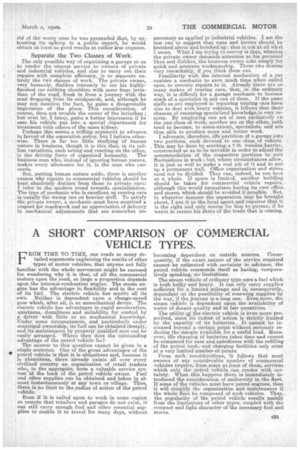A SHORT COMPARISON OF COMMERCIAL VEHICLE TYPES.
Page 11

If you've noticed an error in this article please click here to report it so we can fix it.
FROM TIME TO TIME, one reads so many detailed arguments explaining the merits of other types of motor vehicles, that anyone not fully familiar with the whole movement might be excused for wondering why it is that, of all the commercial motors upon the road, so large a proportion depends upon the internal-combustion engine. The steam engine has the advantage in flexibility and in the cost of its fuel. The electric vehicle has merits all its own. Neither is dependent upon a change-speed gear which, after all, is an unrnechanical device. The electric vehicle has advantages in rapid acceleration, quietness, cleanliness and suitability for control by a driver with little or no mechanical knowledge. Under some circumstances, and particularly under municipal ownership; its fuel can be obtained cheaply, audits maintenance by properly qualified men can be easily arranged. Where then does the outstanding advantage of the petrol vehicle lie?
The answer to this question cannot be given in a single sentence. One of the great advantages of the
• petrol vehicle is thatit is ubiquitous and, because it is ubiquitous, there already exists all over every civilized country an organization of retail traders who, in the aggregate, form a valuable service system at the back of the petrol vehicle owner. Fuel and other supplies can be obtained and taken in almost instantaneously 'at any town or village. Thus, there is no limit to the radius of action of the petrol vehicle.
Even if it is Called upon to work in some region so remote that retailers and garages do not exist, it can still carry enough fuel and other essential supplies to enable it to travel for many days, without
becoming dependent on outside sources. Consequently, if the exact nature of the service required cannot be estimated with certainty in advance, the petrol vehicle commends itself as having, comparatively speaking,: no. limitations.
The steam vehicle of ordinary type uses a fuel which is both bulky and heavy. It can einly carry supplies sufficient for a limited mileage and is, consequently, dependent ora the possibility of renewing supplies by the wee', if the journey is-a long one. Even more, the steam yehicle is dependent upon. the availability of water of decent quality and in fair quantities.
The utility .of the electric vehicle is even more prescribed, since its radiue of action is strictly limited by the capacity of ite batteries.. It cannot be increased beyond a certain point without seriously reducing the margin available for a useful load. Moreover, tile charging of batteries takes time and cannot be compared for ease and. speediness with the refilling of the petrol tank,: and charging facilities only exist at a very hunted number of points.
From such considerations, it follows that most owners of any considerable number of commercial vehicles require, from some at least of them, services which only the petrol vehicle can render with certainty. When this happeus there is immediately introduced the consideration of uniformity in the.fleet. If some of the vehicles must have petrol engines, then it will simplify the organization and maintenance if the whole fleet be composed of such vehicles. . Thus, the popularity of the petrol vehicle results mainly from the limitations of other types; coupled with the compact and light character of the necessary fuel and stores.


































